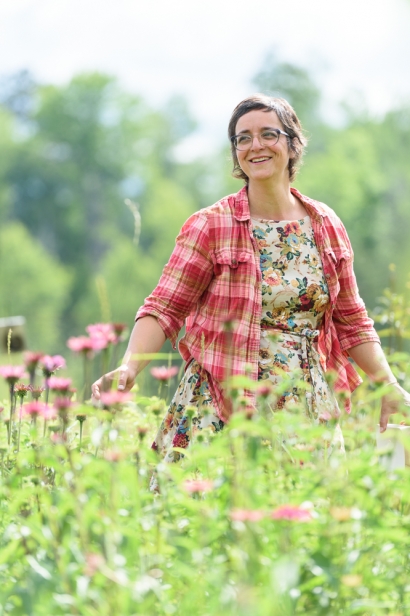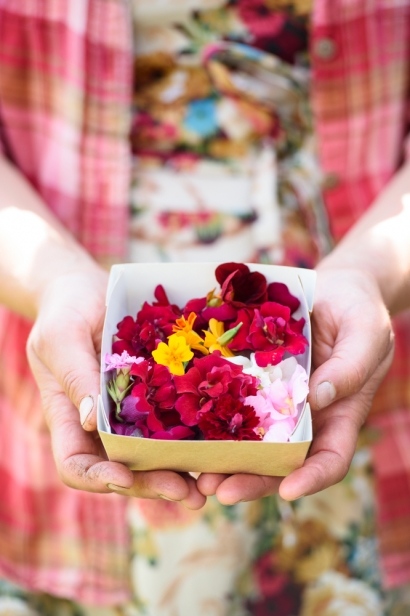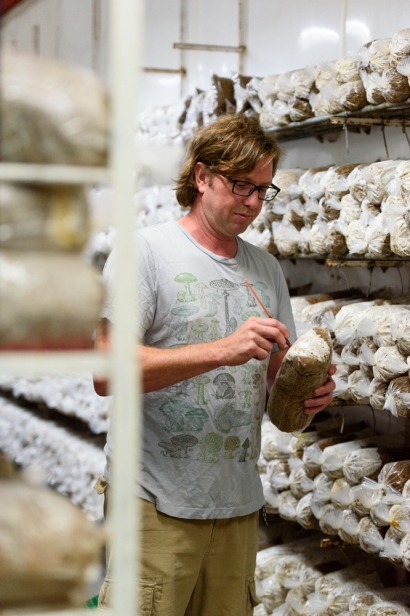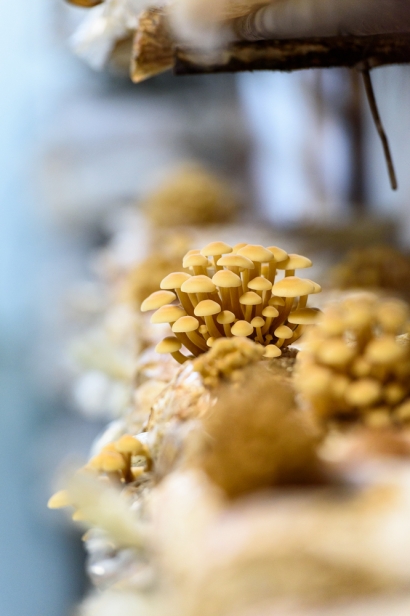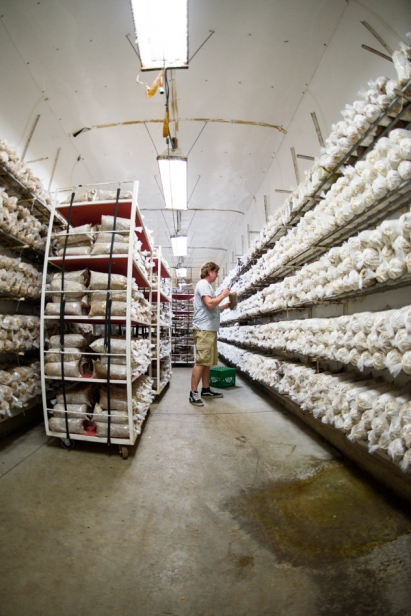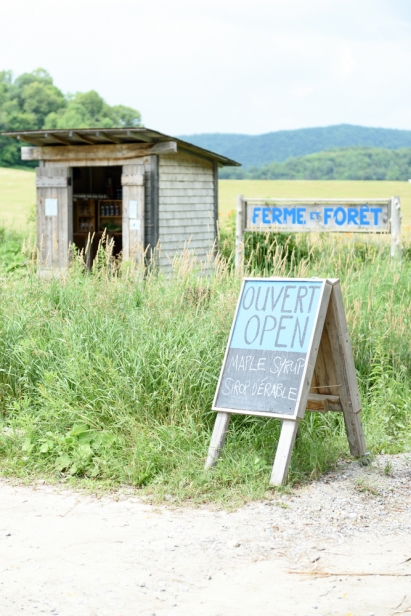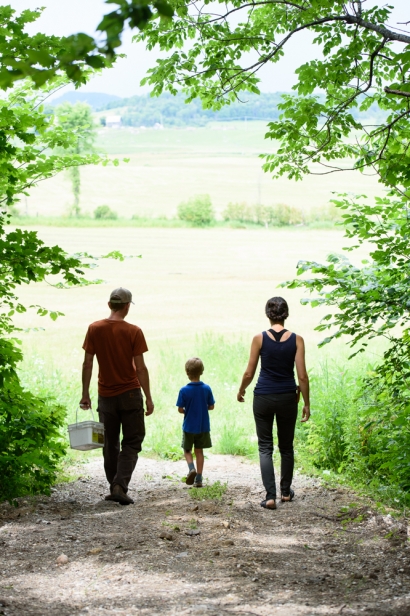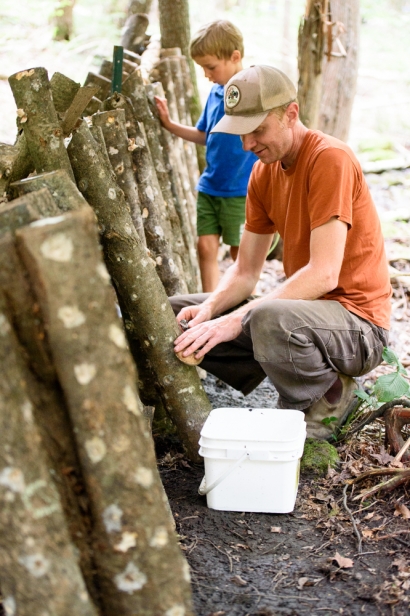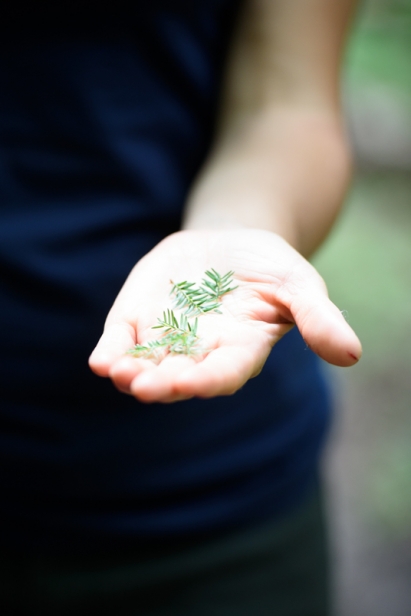The Wonders of Wakefield
Franktown House Flowers
There can hardly be a more beautiful “office” than the land that is Franktown House Flowers. Set between a towering hillside and dense woodland, hidden down a winding driveway, Danielle Schami’s flower farm stretches into the golden heat of a late August morning, heavy with dew.
It’s been a wet summer and many of her edible flowering plants are slow to bloom, but there’s still a rainbow of colours to dazzle the eye. Schami moves quickly down the rows, gathering snapdragon, anise hyssop, Thai basil flowers, nasturtiums, borage and runner-bean flowers to fulfil her weekly order for edible flowers, for delivery to Fairouz, the Château Laurier, Beckta, Riviera and Datsun, to name just a few restaurants in Ottawa.
Next, wearing gloves and with great delicacy to avoid bruising or crushing the flowers, she puts them into medium- or large-sized cardboard boxes with mixed candy-coloured blooms. They look too pretty to eat.
After packaging the flowers, she turns her attention to a pair of large boxes of crab apples at her feet. Neighbours and their children had come by for a harvesting party the previous day, but now the crabapples they harvested require sorting and weighing for a large order from an Ottawa restaurant. We pick through them, removing small branches and any that are bruised or eaten by pests, until we have 14 pounds of perfect fruit at our feet.
This season will be Franktown House Flowers fifth in production. Last year, Schami expanded her edible offerings, producing her first crop of saffron, from 500 French crocus corms, planted in July 2016, harvested in late October and November. “It’s a fascinating crop,” she explains, “with a counter-intuitive cycle as the dormancy period is in the heat of the season.” She aims to more than double the crop this year.
Saffron imparts a distinct flavor and golden hue to any dish that it graces, and it’s worth about as much, retailing at $30 a gram.
In her first season Schami sold the tiny golden strands in airtighglass jars in quantities weighing a quarter-, one-half- and one-gram. “It’s important for saffron to be stored in airtight containers and away from direct light. In this way, it can be kept for three to four years,” she explains.
When Schami and her husband Larry McNeely bought the 70-acre farm, there was a crabapple tree, 20 peonies and not much else. Now, they harvest over 100 varieties of cut flowers, mostly for the summer wedding market and bouquets for weekly appearances at the Hull and Wakefield Farmers’ Markets and at the Wakefield General Store. This year, they’ve added roses to the mix and have been offering a cut flower bouquet share in partnership with Ferme Lève-Tôt’s vegetable CSA deliveries in New Edinburgh.
Schami studied agriculture in her early 20s and did an internship on a flower farm in California. More recently, she has worked for the Public Service in Ottawa, engaging the public, NGOs and indigenous groups on issues of the environment and climate change.
However, a chance encounter with Jenny Love, the founder and owner of Love and Fresh Flowers, a business based near Philadelphia, inspired the Franktown House endeavour. “Buying a farm had been on my wish list since I went to agriculture college in the early to mid 1990s,” Schami explains. “I had been actively looking since 2005 and more intensively since 2008. We agreed on the purchase at the end of 2012.” The rest, as they say, is history, painted in the sublime palette of abundant flowers of summer.
Franktown House Flowers
Wakefield, Qué.
franktownhouse.ca, 819.459.3181
Edible Flowers
Among the fields of flowers, Schami grows 15 to 20 varieties of edible flowers using organic practices. Get past their beautiful exterior and you'll discover flavours ranging from sweet and spicy to floral and peppery.
Ready to take your first bite? Start gently by tossing a few blossoms into a salad or on top of a cupcake. Want to jump in? Make a flowerinfused simple syrup, fruit compote or incorporate flowers into homemade popsicles, pannacotta or goat cheese.
Sweet varieties: scarlet runner beans, pansies
Spicy varieties: gem marigold, oregano blossoms
Peppery varieties: nasturiums, stock (tastes like radish)
Floral varieties: borage, centaurea, pansies, stock
Specialty flavours: snapdragons (bitter), anise hyssop (licorice) and gem marigold (citrus)
Le Coprin
Christophe Marineau-Mes, who, with his wife Marie-Elise Trottier, own Le Coprin organic mushroom farm, has been producing many different varieties of fungus in the area for nearly 15 years. Ten years ago he decided to put down permanent roots and bought some land in Farrellton, 10 minutes north of the village. First he built a hangar-type building, which he has subsequently sub-divided into temperature- and humidity-controlled growing rooms.
Rolling metal shelves are lined with thousands upon thousands of plastic bags, each one filled with a magic mixture of sawdust, wheat bran and lye. The bags — 1,800 weekly — are filled and sealed on-site, then steamed to high temperatures to kill any bacteria that may have sneaked in during this first step. Then, they’re ready to start the important business of providing the growing medium for blue oyster, pearl oyster, shiitake, eryngii, winter and cinnamon cap mushrooms.
Christophe and his assistant Jennifer McDougall inject each bag with spawn, using a long needle. This spawn is a secret, proprietary mixture of the essence of live mushroom spores. The bags are then transferred to a spawn room and kept at a temperature between 20 and 25 degrees Celsius. Once the mycelium have grown inside the bags — and the time this takes varies widely from one mushroom variety to the next — they are moved to other rooms, with different levels of humidity, typically between 80 and 100 per cent and below 18 degrees Celsius, which encourages final fruiting.
Fruiting, the moment when the mushroom begins to sprout through holes made in the plastic growing bags with a knife, can take about one month for the cinnamon cap, to just a few days for varieties of oyster mushrooms, while shiitakes take between 10 and 20 days.
The ideal harvesting period for a mushroom is not long. It can spoil in a matter of hours, so Marineau-Mes harvests twice daily, to maintain the high quality for which he is recognized by top chefs from around the region. “It’s important to pick the mush room at the best time,” he says with a tired sigh, “as my main goal is to produce consistent, great-quality products.” It’s a schedule as demanding as that of a dairy farmer and one that produces between 300 and 350 kilograms of mushrooms weekly for restaurants, and shops such as Herb & Spice on Wellington and the ByWard Fruit Market.
Like all agricultural endeavours, mushroom farming has its challenges. And the greatest of these is variations in temperature. Mushrooms are delicate characters and they just don’t like it when it gets too hot or too cold. “Last summer was a real struggle,” acknowledges Marineau-Mes, “because we had such prolonged high temperatures.” If temperatures go into the 30s for more than a few days, it becomes impossible to keep the growing rooms at the right temperature. The tangible effects of global warming are being felt very close to home.
Marineau-Mes, has been obsessed with mushrooms, plants and medicinals since he was in his mid-teens. “All my books were on this subject,” he recalls. After high school he studied the arts and philosophy at the University of Ottawa, followed by a stint at chef school, which didn’t work out. He learned the art and science of mushroom farming from an elderly friend in Abitibi. During the summer and fall seasons, they’d pick over 500 pounds of wild mushrooms daily. He still finds time to forage on public land for wild varieties such as chanterelles, black trumpets and morels.
In all honesty, commercial mushroom farming is a finely tuned, scientific, repetitive business, based on a relentless schedule. When conditions are right, mushrooms just keep on growing. For a man who studied philosophy, “the zen nature of repetitive work is calming,” Marineau-Mes says, “even if it’s incredibly hard work with occasional periods of panic.”
le Coprin
Farrellton, Qué.
lecoprin.ca, 819.664.8030
Ferme et Forêt
If you bend down and look at one 10-centimetre square patch of ground, the number of edible plants you will find is astounding.
Geneviève LeGal-Leblanc and Sean Butler, owners of Ferme et Forêt, are very aware of the bounty that nature can provide without encouragement and interference from man. A large part of their livelihood is based upon foraging across farmland far and wide. The other part involves giving nature a hand, in the form of extensive maple syrup harvesting and cultivating mushrooms on logs in the forest.
Their approach to farming is decidedly philosophical and encompasses respect for all life, individual wellbeing, social capital, fair share and ecosystem regeneration. In a nutshell, they believe that farmers should be fairly paid for their work and produce, that the food they produce and sell should taste great and nurture those who eat it, that a farm can be a nexus for better community relations through the shared pleasure of good food and that farmers can help support and regenerate nature.
With this as their mandate, LeGal-Leblanc and Butler produce many thousands of pounds of delicious, quirky, wild and original food from their 154 acres and those owned by neighbours and friends. They sell this to local restaurants, at farmers’ markets and through their farm stand close to Wakefield.
The pair harvests more than 40 different plants, including wild plums, sumac (for berries and juice), wild apples, nettles, juniper berries, fiddleheads, spruce tips, dandelion greens, cattails, milkweed broccoli, elderberries and chokecherries. Though not edible, they also harvest milkweed fibre, that fluffy white stuff you see floating on the breeze at the end of summer, to make absorbent fibre packs and clothing insulation. “That’s one of the most pleasant harvests,” LeGal-Leblanc says, “as we do it only in good weather.”
In a certain sense, LeGal-Leblanc has been a farmer her whole life. “From a very young age I was able to identify many wild plants,” she recalls. “I grew up walking through the woods and munching and going to the sugar bush with my uncle, a professional with 700 taps who would boil [syrup] through the night.”
Her uncle is Gerard LeGal, owner of Gourmet Sauvage, a Québec company that produces boutique wild products for the restaurant industry and discerning consumers. He was also the cohost, with his daughter, of the television show Coureurs des Bois, on Télé-Québec. LeGal-Leblanc studied agriculture at Alfred College, part of the University of Guelph and farmed on a hobby scale on her mother’s property near Renfrew. Butler’s interest in farming stems from his passion for eating good food. He has worked on organic farms from coast-to-coast and completed a Permaculture Design Certificate in 2009.
On their property, LeGal-Leblanc and Butler tap more than 2,500 maple trees with 22 kilometres of lines for syrup and cultivate semi-wild mushrooms — shiitake and wine caps — grown on logs in the forest. Last year, they harvested 120 pounds of shiitakes, which they collect a couple of times weekly, and a few more pounds of wine caps, which need to be harvested daily when they are fruiting. They keep approximately 100 hens and grow a crop of strawberries and raspberries. But over the years they’ve also knocked on plenty of doors to ask landowners if they may forage on their property. Now, they have neighbours offering up their land.
During the winter months when foraging is off the menu, they sell dried mushrooms, herbal teas made from organic cultivated herbs and foraged plants, eggs, maple syrup, sumac juice and granola, made from a recipe of Butler’s grandmother.
But spring is when it all comes together. “My favourite part of my job is boiling maple syrup. We've worked all year to be ready for those few weeks when the syrup pours off the evaporator like liquid gold,” Butler says. “Suffice to say this is also my favourite season.”
Ferme et Forêt
225 Chemin Shouldice, Wakefield, Qué.
fermeetforet.ca, 819.459.3861



